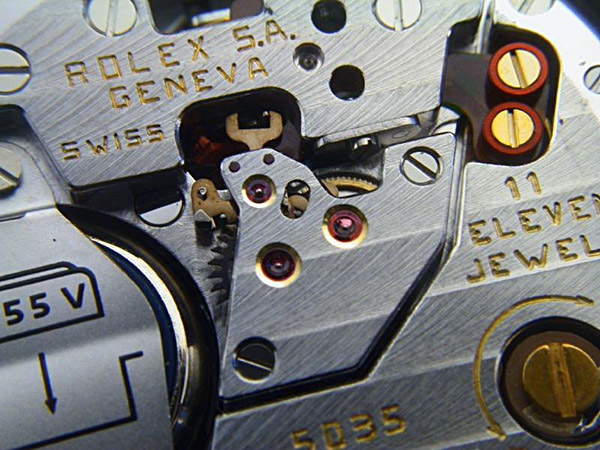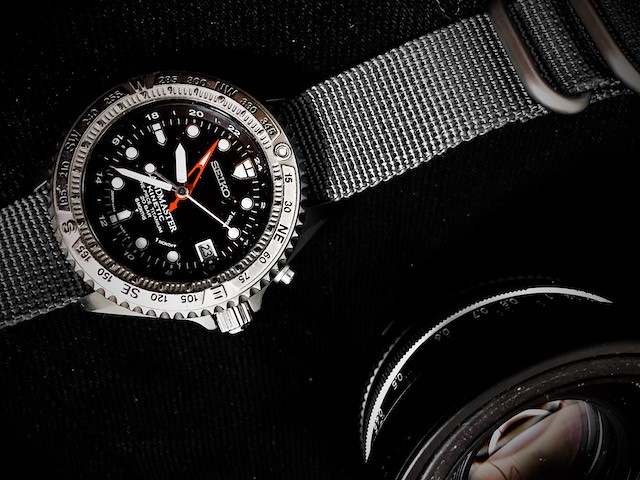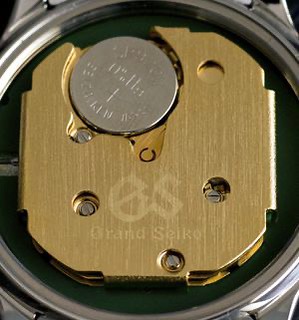The quartz watch is often accused by enthusiasts as being "soul-less". A mass-produced disposable merit-less trinket of zero horological interest. I may have thought so too, at least once upon a time. But I think it is actually an area of incredible variety and interest. Human ingenuity and engineering at its best.
Taking nothing away from the mechanical wonders we enjoy, here are a few I find or found worthy of thought. Just don't expect to see $ value or rarity necessarily promoted as interesting. There is much more to enjoy than bragging rights in this area!
First, let's calibrate ourselves with a standard quartz watch. Here, a simple and functional Tissot:
The movement is nondescript, tiny, generic, and has to wear a plastic spacer like a small child desperately clutching a life-belt:
Perfectly likely to give its owner (me, as it happens) long, economical and trouble-free service.
For watch fans, though, perhaps the epitome of boredom, and maybe watches like these are the source of the "soul-less" reputation.
Moving quickly on then, to a 1978 Omega. It came to me broken and dirty...
50 (1) by Japanpaul, on Flickr
I cleaned it up and fixed it:
As you can see, the movement fits the case without a plastic spacer, and is both beautiful and beautifully engineered. Very similar in quality to mechanical Omegas of the period.
The enclosed drive train is exposed for cleaning and oiling here, showing that "quartz" does not imply "not mechanical".
The time is set by pressing in the very centre of the crown, the hands being smoothly powered around the dial until the pressure is released.
The electronic circuit design is sufficiently well thought through that it functions today on the more environmentally friendly but lower voltage cells than it would have originally been fitted with.
While similar on the outside to the Tissot, on the inside this is an excellent, thoughtful design. Well engineered and executed.
Which brings me nicely to another 70s offering. One of the few expensive quartz models I obtained:
The Rolex Oysterquartz Day Date, released in 1977 with in-house Rolex movement 5055. Movement picture from Oysterquartz.net:
From the same site we take this information, upon which I cannot improve:
Exactly! A lovely thing and these (along with their non-daydate cousins) remain serviceable by Rolex.The drive mechanism for the 5035/5055 is very similar to the design of a traditional mechanical watch escapement. The pulse motor drives a pallet fork which in turn moves a pallet wheel. The loud "tick" you hear every second are the pallets engaging the pallet wheel....
...this movement still remains one of the most "over-engineered" quartz movements ever produced and clearly carries on the Rolex tradition of solid engineering, superb finishing, and understated beauty.
Moving back to earth somewhat, and on to the early 1980s I offer this Seiko 7548-7000:
Interesting because the watch was an upgrade from the much-admired (these days) automatic 6309 and the movement shares the base design.
It is also, I believe, a "twin pulse" quartz movement, Seiko's approach to pushing the seconds-hand around the dial without that common "wall-clock" effect of the wobbly seconds-hand bouncing. An issue with analogue quartz watches due to the relatively low torque (to save battery power) provided, compared to mechanical movements powered by a spring.
I can highly recommend Martin's tear-down of one of these to witness the engineering. It is a site full of information and superb pictures, freely offered.
To the 90s then and these titanium Seikos. A particularly innovative period for Seiko. Pre mobile phones. Seiko were at the height of their powers, developing movement and casing technology, at prices within reasonable reach.
Clockwise from bottom left, a Seiko 8F56, Seiko Landmaster (Ohba limited edition) and Seiko Landmaster 5M45. The 8F56 was Seiko's all-singing all-dancing high-accuracy (less than 20s/year) high-frequency (192KHz) perpetual calendar, GMT movement with a 10 year battery.
Just read that again! What a technical tour-de-force.
The Landmasters I have waxed lyrical about on here many times before, but suffice to say that Seiko were innovating with case materials (using titanium for diving watches before anyone else, the patented L-shaped as opposed to round gaskets, and front-loading movements in monocoque cases) and here they added all of these together with their kinetic movement. Much derided in modern times by watch aficionados but fully deserving of a re-appraisal:
Seiko, Casio and Citizen continued to experiment with new ways to measure time, beyond just the re-arranging of cogs, escapement and a spring. Solar LCD, Solar/capacitor (Eco Drive), Kinetic, Spring drive. Seiko even released a watch powered by thermal energy of the wearer's wrist. Some of these lasted, including the kinetic. It is a miniature marvel of micro-engineering.
If you appreciate mechanical watches for the engineering and craftsmanship aspect, a kinetic (or Spring Drive) movement surely offers even more for your consideration.
These things are not born whole. Teams need to consider, design, and manufacture them successfully. That Seiko continue to do so, and provide kinetic watches at reasonable prices, is a small gift to everyone who appreciates horological variety. The "Journey in Time" book gives an account of the kinetic development, and is well worth a read, as is the Landmaster history here.
From the same era we have this from Citizen:
Eco Drive PMX56-2591
The interest here is the combination of one-piece "Duratect" hardened titanium case with Citizen's Eco-Drive movement. Always accurate, minimal maintenance at least until the capacitor/battery needs to be replaced (Citizen's estimate is 18-20 years) and reasonably priced.
No "interesting quartz" discussion would be complete without a mention of Grand Seiko. Seiko, who grow their own quartz crystals and even for their cheapest watches, produce everything in-house, never stopped refining the quartz movement. Their current thermo-compensated twin-pulse 9F movements are rightly considered some of the very best available. This earlier 8F movement is also interesting in that it offers an independently movable hour-hand, unlike the 9F.
(cover removed)
The rarer 9F82 is a slightly thinner version of the popular 9F62, making this one of my most svelte analogue watches:
Echoing back to the 7548 Seiko dive watch, the more recent models sport the 7C46 movement, such as my Marinemaster 1000m:
This combines Seiko's one-piece case in titanium, a ceramic shroud, sapphire glass and those L-shaped gaskets to achieve its 1000m water resistance without excessive weight nor requirement for an helium release valve.
The high quality 7-jewelled 7C46 movement is no longer twin-pulse but has boosted torque to drive those large hands, yet still manages a battery life of 5 years. The same rugged movement powers my 300m Tuna, too:
Somewhere between these things and the run-of-the-mill movements are the analogue-digital mechanisms. In my opinion it is difficult to harmoniously integrate a digital display with an analogue dial, but I find this Hermès model has achieved a reasonable look:
It uses an ETA movement, also fitted to older Omega and TAG models. Interesting in that the entire watch, including analogue and digital functions (stopwatch, countdown timer, alarm, dual time) can be controlled by the single crown.
I find the thought that someone, or some team, had to sit down and work all this out and bring it market right first time (no "software update") as intriguing as any tale of mechanical watch development. The smart person's smart watch, perhaps.
I hope this little review of not particularly rare, expensive nor idolised models was interesting. Please feel free to post your own interesting quartzes!
Paul

























 Reply With Quote
Reply With Quote